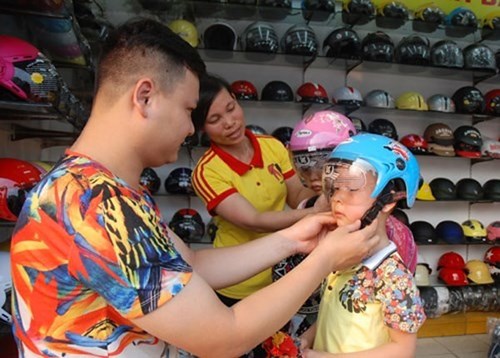At present, the helmet law, called resolution number 32, is estimated to have created a substantial uptick in the number of riders who wear helmets in urban areas, from 30 percent in 2007 to 90 percent today.
    |
 |
| Ten years after it came into effect, Vietnam’s helmet law still struggles to address quality issues and raise motorbike riders’ awareness of the need for safe helmets. (Photo for illustration: kinhtedothi.vn) |
The Asian Injury Prevention Foundation (AIP) estimates that some 500,000 cases of head injury and 15,000 deaths were prevented thanks to standardised helmets. Therefore, the country has saved 3.5 billion USD in healthcare and injury treatment costs.
Hoang Thi Na Huong, AIP’s deputy CEO, told the Kinh te & Do Thi (Economic & Urban Affairs) newspaper that she believes the helmet plays a major role in limiting traffic injuries and deaths.
“With the good practice of wearing helmets, Vietnam is now recognised among developing countries for its positive achievements in traffic safety,” she said.
But the resolution’s enforcement faces several challenges.
In countryside and suburban areas, only 50 to 60 percent of motorbike riders wear helmets. Moreover, up to 40 percent current helmets are low quality, offering no protection at all, according to the National Traffic Safety Committee (NTSC).
Luu Xuan Binh, deputy head of office of Hanoi Traffic Safety Committee, said the low proportion of children wearing helmets needs to be addressed.
“I have witnessed many traffic accidents involving students. If only they had worn helmets, those horrendous long-term injuries would have been avoided,” he said.
After the law was introduced, the media raised the suggestion that wearing helmets may cause damage to children’s necks. Although many experts argue against the unreasonable hypothesis, many parents still refuse to get helmets for their children.
The ineffectiveness of awareness-raising campaigns was cited by Huong as the reason for the phenomenon. Loose enforcement, on the other hand, explains the low rate of wearing helmets in rural areas, she said.
Stronger actions requested “I don’t want to wear a helmet as it can damage my makeup look and hair style,” said Nguyen Thu Huong of Ha Dong district. And Huong is not in the minority.
Nguyen Duc Kha, head of office for the Hanoi Traffic Safety Committee, stressed that the poor awareness of motorbike riders is the main cause for disobeying the law.
“Moreover, some people know about the importance of helmets but they deliberately ignore it, citing inadequate reasons,” he said.
The circulation of poor quality helmet worsens the problem. The poor regulation of the sale of those products, priced from 15,000 to 50,000 VND (0.6- 2.2 USD), renders Resolution No 32 less effective.
“The four ministries of Transport, Science and Technology, Public Security and Industry and Trade have not yet adopted any strong action to deal with poor quality helmets. If the situation continues, the effort to call for people wearing helmets in the past ten years may not achieve expected results,” Huong said.
Traffic expert Nguyen Manh Thang suggested related agencies should collaborate in tightening helmet management.
According to him, the Ministry of Industry and Trade should develop monitoring tools for police to easily detect poor quality helmets.
“We have to strictly handle the industry of poor helmets as they are earning money on people’s lives,” he stressed.
Binh, on the other hand, called for parents’ cooperation in expecting their children to wear helmets.
"I think we should make it mandatory for children at all ages to wear helmets," he said.
Moreover, teachers and families should pay attention to provide them with protection skills, including wearing helmets when riding motorbikes, he suggested.
The data from the National Traffic Safety Committee shows that 80 percent of road traffic accident deaths are related to motorbikes. Wearing a helmet helps to reduce head injury risk by 60 percent and mortality risk by 40 percent.
Source: VNA